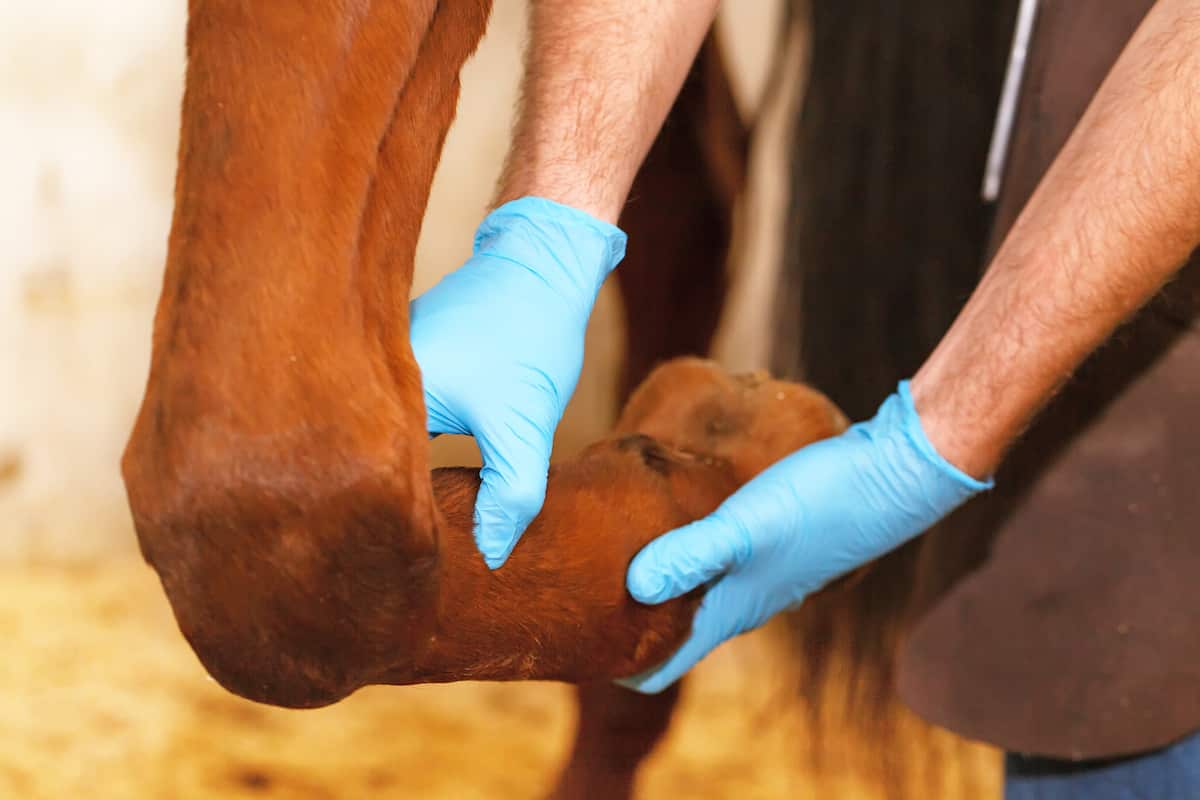How to rehab an injured ex-racehorse and prevent re-injury down the road.

The repeated stress and strain on horses’ tendons and ligaments during racing can result in injury. Courtesy istock.com
Tendon injuries are tricky. They can range from minor strains to full-blown bows. Some heal nicely with no lingering signs of lameness, while others require lifelong management.
Racehorses pushed to their max can suffer these insults, so it’s important we know how to handle them. It’s also important that we don’t overlook the OTTB for sale with the old racing injury but, rather, understand how to keep him sound in his second career.
We talked to two veterinarians with both racing and sport horse clientele about how to deal with racing-related tendon injuries.
What types of tendon injuries might I find in an ex-racehorse?
Tendons attach muscle to bone; ligaments connect bones or cartilage. Racehorses can strain and tear these fibrous tissues because they’re working not only at very high speeds but also in deep footing or with long toe/low heel conformation, fatigue or improper training.
“When one or more of these factors is in play, the repeated stress and strain on the tendons and ligaments of the limbs can result in injury,” says Elysia Schaefer, DVM, MS, Dipl. ACVS, of Unionville Equine Associates, in Oxford, Pennsylvania. “If you’ve ever watched a slow-motion video of a racehorse galloping down the track, you can appreciate the significant hyperextension of the fetlock and imagine the massive biomechanical forces stretching those tendons and ligaments with each stride.”
In racehorses these injuries most frequently involve the superficial or deep flexor tendon, the suspensory ligament or the collateral ligaments.
Melissa McKee, DVM, of McKee-Pownall Equine Services, in Ontario, Canada, says that by far the most common injury you’ll see in a retired Thoroughbred racehorse would be a bowed tendon in the front limb.
This injury — typically to the superficial digital flexor tendon that courses down the back of the cannon bone — is easy to spot. It gives the leg that characteristic thickening or “hotdoglike” appearance, she says.
A bow is the most extreme tendon injury. Horses might also come off the track with much more subtle injuries: minor strains, which involve rupture of just a few of the tiny tendon fibrils, says McKee, or tendinitis, which is inflammation without any torn fibers.
My horse retired off the track with a tendon injury that’s currently healing. How do I rehab him?
First and foremost, get your veterinarian involved. He or she will perform an ultrasound exam to find out exactly where the injury is located, how severe it is and what degree of healing has already occurred. This information will direct your rehab approach and how quickly you can bring the horse back into work, says McKee.
Be patient, though. “Tendon and ligament injuries can take several months to a year to heal, so it is important to assess the injury (incrementally) before increasing exercise or turnout to make sure it is continuing to heal,” says Schaefer.
If it’s early in the healing process, your veterinarian might instruct you to keep the horse on stall rest with pain management, pressure bandaging (be sure to have him or her show you how) and/or regular icing (e.g., cold hosing, ice boots), she says.
Other therapies and approaches might include stem cell, platelet-rich plasma, laser, shock wave and tendon splitting. “Many of these treatment modalities are most beneficial in the earlier stages of the injury, after the initial swelling, heat and pain have subsided,” she adds.
Then, once the horse is past the initial injury phase, your veterinarian might incorporate rehabilitative modalities such as underwater treadmills, swimming pools, vibration therapy and more.
“The most important aspect of rehab is taking the time to let the injury heal properly before putting the horse back into work,” says Schaefer.
My horse has an old bowed tendon, but is sound. How do I prevent re-injury?
“If you are purchasing a horse that has had a previous injury, find out what you can about when it occurred, what kind of rehab program it underwent and what work the horse is currently doing,” says Schaefer.
You might do this in tandem with a prepurchase exam that includes ultrasound.
Also establish a good relationship with a farrier, if you don’t already have one, and be sure the horse’s feet are trimmed regularly and protected as needed. If, for instance, your horse came off the track with a long toe and an underrun heel or he simply doesn’t have much hoof mass, he’ll likely benefit from being shod, says McKee. Your farrier will want to make sure the horse lands balanced and has an easy breakover (the moment each heel lifts off the ground during movement).
After heavy exercise, such as an intense jump school, these horses might benefit from icing and poulticing.
“If the horse is in heavy work, the use of tendon support boots, limb poultice after work to draw out inflammation or cooling boots after a workout may all help to prevent re-injury,” says Schaefer.
McKee cautions against micromanaging, however. “I try not to get too intensive in their management because if there is a subtle problem, I’d rather spot it early than cover it up with supportive care and enable it to get far worse before it really comes to light. If you get to the point that the horse needs to be wrapped constantly or needs a lot of nursing care for the legs to look good, I’m worried we’re asking for more than the horse can handle.”
As the horse’s training progresses, keep your riding expectations realistic, follow your veterinarian’s recommendations and don’t push the horse too hard too fast.
“The biggest key to preventing re-injury is to properly condition your horse for your desired level of riding,” says Schaefer, adding that a good warmup and cool-down pre- and post-exercise are also important.
What signs of possible re-injury should I look for?
“The trouble with tendon and ligament injuries is that even with the best of care, the healed tendon structure isn’t completely normal, and it doesn’t have the same elasticity as original healthy tendon,” McKee says.
So when the tendon or ligament gets stretched to its max, the horse is at risk of a repeat injury right where the flexible healthy tendon attaches to the less flexible fibrous scar tissue, typically at the top or bottom of the original tear, she says.
Signs McKee and Schaefer say might point to re-injury include:
■ Lameness when longed or ridden;
■ Soreness when you squeeze the tendon or gently flex the limb;
■ Heat or swelling over the previously injured site;
■ Tentativeness or a shortened stride when coming out of the stall and hitting the hard pavement of the barn aisle;
■ Reluctance to pick up one of the front legs for the farrier;
■ Progressively longer periods of warmup to get the horse loosened up;
■ New issues under saddle, such as drifting one direction or getting heavy in the hand;
■ Body language such as pointing a forefoot repeatedly or resting one hind leg consistently; and
■ Behaviors such as backing up in the stall, rubbing the hindquarters on or kicking the wall and digging the shavings into a pile and standing with either the front or hind legs elevated on it.
“These are subtle clues that the horse isn’t feeling 100%,” says McKee.
To better pick up on these, says Schaefer, know what’s normal for your horse, and run your hands over his legs every day to feel for deviations from that normal.
Take-Home Message
“The majority of horses who are rehabbed properly can go on to have athletic careers, depending on the severity of the injury,” says Schaefer.
You just have to make a realistic assessment, with your trainer and veterinarian’s help, as to that horse’s abilities in his post-racing career.
“Lots of Thoroughbreds are incredibly athletic, but not every Thoroughbred is able to go on to, say, an intensive three-day eventing career after it’s retired at the racetrack,” says McKee.
So treat each horse an as individual post-tendon-injury, and don’t push him past what he’s physically comfortable doing.
Don’t Ignore the Opposing Limb
Based on her experience working with sport horses and off-track Thoroughbreds, Melissa McKee, DVM, of McKee-Pownall Equine Services, in Ontario, Canada, says tendon injuries can actually be clues that something is bothering the horse in the other limb.
“I find that Thoroughbreds with tendon injuries will often have a concurrent orthopedic injury on the opposite leg, and the tendons have actually been damaged secondary to shifting the weight away from the initially sore leg,” she says.
“So, if there’s a bowed tendon on the left front, I’d also want to keep a lookout out for chips in the fetlock or the knee on the right front leg that might have caused the horse to overload the tendon in the first place.”

